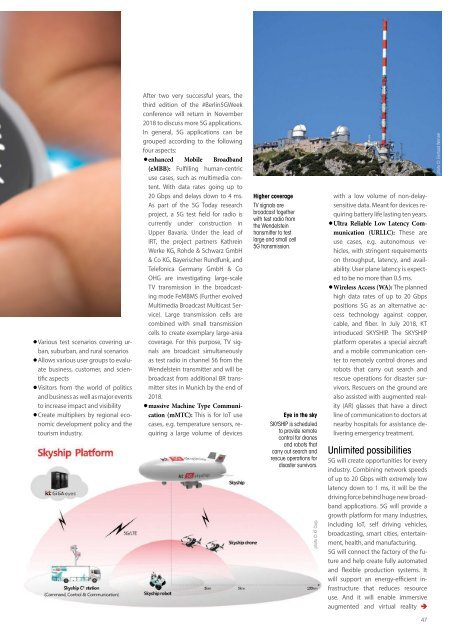Smart Industry 2/2018
Smart Industry 2/2018 - The IoT Business Magazine - powered by Avnet Silica
Smart Industry 2/2018 - The IoT Business Magazine - powered by Avnet Silica
Create successful ePaper yourself
Turn your PDF publications into a flip-book with our unique Google optimized e-Paper software.
• Various test scenarios covering urban,<br />
suburban, and rural scenarios<br />
• Allows various user groups to evaluate<br />
business, customer, and scientific<br />
aspects<br />
• Visitors from the world of politics<br />
and business as well as major events<br />
to increase impact and visibility<br />
• Create multipliers by regional economic<br />
development policy and the<br />
tourism industry.<br />
After two very successful years, the<br />
third edition of the #Berlin5GWeek<br />
conference will return in November<br />
<strong>2018</strong> to discuss more 5G applications.<br />
In general, 5G applications can be<br />
grouped according to the following<br />
four aspects:<br />
• enhanced Mobile Broadband<br />
(eMBB): Fulfilling human-centric<br />
use cases, such as multimedia content.<br />
With data rates going up to<br />
20 Gbps and delays down to 4 ms.<br />
As part of the 5G Today research<br />
project, a 5G test field for radio is<br />
currently under construction in<br />
Upper Bavaria. Under the lead of<br />
IRT, the project partners Kathrein<br />
Werke KG, Rohde & Schwarz GmbH<br />
& Co KG, Bayerischer Rundfunk, and<br />
Telefonica Germany GmbH & Co<br />
OHG are investigating large-scale<br />
TV transmission in the broadcasting<br />
mode FeMBMS (Further evolved<br />
Multimedia Broadcast Multicast Service).<br />
Large transmission cells are<br />
combined with small transmission<br />
cells to create exemplary large-area<br />
coverage. For this purpose, TV signals<br />
are broadcast simultaneously<br />
as test radio in channel 56 from the<br />
Wendelstein transmitter and will be<br />
broadcast from additional BR transmitter<br />
sites in Munich by the end of<br />
<strong>2018</strong>.<br />
• massive Machine Type Communication<br />
(mMTC): This is for IoT use<br />
cases, e.g. temperature sensors, requiring<br />
a large volume of devices<br />
Higher coverage<br />
TV signals are<br />
broadcast together<br />
with test radio from<br />
the Wendelstein<br />
transmitter to test<br />
large and small cell<br />
5G transmission.<br />
Eye in the sky<br />
SKYSHIP is scheduled<br />
to provide remote<br />
control for drones<br />
and robots that<br />
carry out search and<br />
rescue operations for<br />
disaster survivors.<br />
photo ©: KT Corp.<br />
with a low volume of non-delaysensitive<br />
data. Meant for devices requiring<br />
battery life lasting ten years.<br />
Ultra Reliable Low Latency Communication<br />
(URLLC): These are<br />
use cases, e.g. autonomous vehicles,<br />
with stringent requirements<br />
on throughput, latency, and availability.<br />
User plane latency is expected<br />
to be no more than 0.5 ms.<br />
Wireless Access (WA): The planned<br />
high data rates of up to 20 Gbps<br />
positions 5G as an alternative access<br />
technology against copper,<br />
cable, and fiber. In July <strong>2018</strong>, KT<br />
introduced SKYSHIP. The SKYSHIP<br />
platform operates a special aircraft<br />
and a mobile communication center<br />
to remotely control drones and<br />
robots that carry out search and<br />
rescue operations for disaster survivors.<br />
Rescuers on the ground are<br />
also assisted with augmented reality<br />
(AR) glasses that have a direct<br />
line of communication to doctors at<br />
nearby hospitals for assistance delivering<br />
emergency treatment.<br />
•<br />
•<br />
Unlimited possibilities<br />
5G will create opportunities for every<br />
industry. Combining network speeds<br />
of up to 20 Gbps with extremely low<br />
latency down to 1 ms, it will be the<br />
driving force behind huge new broadband<br />
applications. 5G will provide a<br />
growth platform for many industries,<br />
including IoT, self driving vehicles,<br />
broadcasting, smart cities, entertainment,<br />
health, and manufacturing.<br />
5G will connect the factory of the future<br />
and help create fully automated<br />
and flexible production systems. It<br />
will support an energy-efficient infrastructure<br />
that reduces resource<br />
use. And it will enable immersive<br />
augmented and virtual reality<br />
photo ©: Gerhard Wenzel<br />
47
















